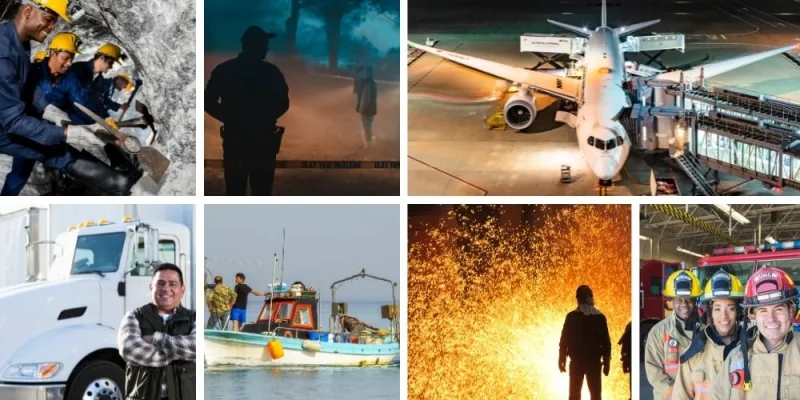The Most Dangerous Jobs in the World: Risks, Realities, and Safety Measures

While many jobs involve some level of risk, certain professions expose workers to life-threatening hazards daily. From extreme weather to heavy machinery, toxic substances to high-risk environments, these jobs demand courage, skill, and strict safety measures.
In this guide, we’ll explore the most dangerous jobs in the world, what makes them risky, and how workers minimize danger while performing them.
What Makes a Job Dangerous?
A dangerous job typically has:
- High fatality rates compared to average professions
- Frequent exposure to hazardous environments
- Physical strain and demanding conditions
- Unpredictable threats such as weather, accidents, or violence
These jobs are often necessary for society’s functioning, making them both essential and high-risk.
The Most Dangerous Jobs in the World
Logging Workers
Fatality Rate: Around 135.9 deaths per 100,000 workers (U.S. Bureau of Labor Statistics)
Why It’s Dangerous:
- Operating chainsaws and heavy logging equipment
- Falling trees and branches
- Working in remote, uneven terrain
- Harsh weather conditions
Safety Measures:
- Wearing helmets, goggles, and chainsaw-protective clothing
- Team communication and logging site planning
- Strict adherence to felling techniques
Commercial Fishing Workers
Fatality Rate: About 86 deaths per 100,000 workers
Why It’s Dangerous:
- Storms, rough seas, and unpredictable weather
- Heavy fishing gear and winches
- Risk of drowning and hypothermia
Safety Measures:
- Survival suits and flotation devices
- Weather monitoring before trips
- Training in man-overboard procedures
Aircraft Pilots and Flight Engineers (Non-commercial & Cargo)
Fatality Rate: Around 55.5 deaths per 100,000 workers
Why It’s Dangerous:
- Operating in difficult weather or landing conditions
- Mechanical failures
- Long working hours and fatigue
Safety Measures:
- Strict maintenance schedules
- Flight simulation and emergency training
- Adherence to rest period regulations
Roofers
Fatality Rate: 47 deaths per 100,000 workers
Why It’s Dangerous:
- Falls from heights
- Exposure to extreme heat or cold
- Slippery surfaces during rain or ice
Safety Measures:
- Use of safety harnesses and guardrails
- Fall prevention training
- Wearing non-slip footwear
Construction Workers
Fatality Rate: Varies by role; high rates for ironworkers and crane operators
Why It’s Dangerous:
- Falls from scaffolding and ladders
- Heavy equipment accidents
- Falling debris and structural collapses
Safety Measures:
- Hard hats, safety vests, and protective boots
- Site safety inspections
- Crane and equipment operation training
Miners
Why It’s Dangerous:
- Risk of cave-ins and rockfalls
- Toxic gas exposure
- Explosions from methane buildup
- Long-term respiratory health risks
Safety Measures:
- Gas detection equipment
- Ventilation systems
- Emergency evacuation drills
Firefighters
Why It’s Dangerous:
- Burns, smoke inhalation, and building collapses
- Heat exhaustion and dehydration
- Exposure to hazardous chemicals
Safety Measures:
- Fire-resistant suits and breathing apparatus
- Team coordination and communication
- Rapid incident assessment
Oil and Gas Extraction Workers
Why It’s Dangerous:
- Explosions and fires from flammable gases
- Equipment malfunctions
- Harsh offshore or desert environments
Safety Measures:
- Rig safety training and certifications
- Blowout preventers and pressure control systems
- Emergency medical preparedness
Law Enforcement Officers
Why It’s Dangerous:
- Armed confrontations and violent incidents
- Traffic-related injuries during pursuits
- High-stress decision-making under pressure
Safety Measures:
- Body armor and tactical equipment
- Crisis negotiation and de-escalation training
- Use of non-lethal enforcement tools
Military Personnel in Combat Roles
Why It’s Dangerous:
- Armed conflict and explosives
- Harsh environments with limited medical access
- Physical and mental strain
Safety Measures:
- Combat training and tactical planning
- Advanced protective gear
- Field medical units and evacuation protocols
Stunt Performers
Why It’s Dangerous:
- Falls, high-speed chases, fire stunts
- Unpredictable environmental hazards on set
Safety Measures:
- Rigorous rehearsals and stunt coordination
- Protective padding and harness systems
- On-set safety officers
Electrical Power Line Installers and Repairers
Why It’s Dangerous:
- High-voltage electrocution risk
- Falls from poles or towers
- Severe weather exposure
Safety Measures:
- Insulated tools and gloves
- Lockout/tagout procedures
- Bucket trucks and fall protection gear
Global Risk Variation
The danger level for each job varies by country, safety regulations, and technology access. For example:
- In countries with weaker labor laws, fatality rates tend to be higher.
- Automation and modern equipment reduce risk in developed economies.
- Harsh climates—such as Arctic fishing zones or desert oil fields—add another layer of danger.
Safety Innovations Reducing Risk
Even in high-risk industries, technology is helping improve safety:
- Drones for inspecting dangerous areas (construction, power lines)
- Wearable sensors to monitor worker health in real-time
- Remote-operated machinery in mining and oil drilling
- AI weather forecasting for fishing and aviation
The Psychological Toll of Dangerous Jobs
Physical risks aren’t the only concern—many high-risk jobs also carry mental and emotional stress:
- Constant alertness can lead to burnout
- PTSD is common in combat roles, firefighting, and law enforcement
- Long periods away from family (offshore rigs, military) affect mental health
Employers in these industries are increasingly providing mental health support and counseling alongside physical safety measures.
How Workers Can Stay Safe in High-Risk Jobs
- Follow Safety Protocols – Never skip protective measures, even if it slows down work.
- Keep Skills Updated – Regular training reduces accident risk.
- Report Hazards Immediately – Early reporting prevents bigger incidents.
- Prioritize Physical Fitness – Strength, endurance, and flexibility improve safety.
- Use Proper PPE (Personal Protective Equipment) – Helmets, harnesses, gloves, masks, etc.
Conclusion
The most dangerous jobs in the world are often those that society depends on the most—logging for building materials, fishing for food, firefighting for community safety, and law enforcement for order. While these careers come with significant risks, training, technology, and a strong safety culture can make them more manageable.
For those drawn to these roles, passion, preparedness, and respect for safety protocols are essential for not only surviving but thriving in high-risk professions.
FAQs
1. What job has the highest fatality rate in the world?
Logging consistently ranks among the deadliest due to falling trees and heavy machinery.
2. Are dangerous jobs always high-paying?
Not always—while some offer hazard pay, others (like firefighting) are modestly paid despite high risks.
3. Can technology make these jobs completely safe?
Technology greatly reduces risk, but in many cases, human presence in hazardous environments is still necessary.
4. Which dangerous jobs are in highest demand?
Oil rig workers, electricians, and law enforcement officers are consistently in demand worldwide.
5. What’s the safest way to enter a dangerous profession?
Through accredited training programs that emphasize safety, backed by employers with strong safety cultures.
Also read: T-Shirt Printing Business Start-Up Cost in 2025: Complete Breakdown











